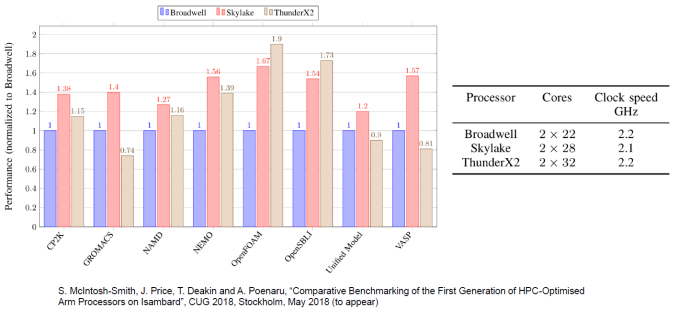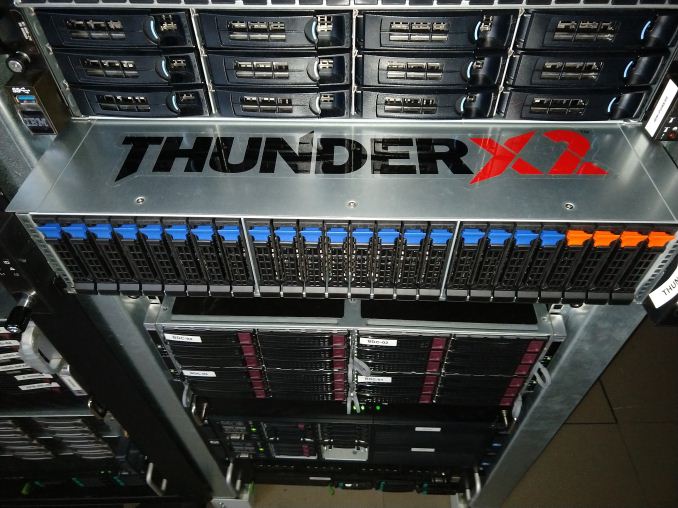Assessing Cavium's ThunderX2: The Arm Server Dream Realized At Last
by Johan De Gelas on May 23, 2018 9:00 AM EST- Posted in
- CPUs
- Arm
- Enterprise
- SoCs
- Enterprise CPUs
- ARMv8
- Cavium
- ThunderX
- ThunderX2
What We Can Conclude: So Far
Wrapping things up, our SPECInt analyses show that the ThunderX2 cores still has some weaknesses. Our first impression is that branch intensive code – especially in combination with regular L3-cache misses (high DRAM latency) – run quite a bit slower. So there will be corner cases where the ThunderX2 is not the best choice.
However, other than some niche markets, we are pretty confident that the ThunderX2 will be a solid performer. For example, the performance measurements done by our colleagues at the University of Bristol confirm our suspicion that memory intensive HPC workloads such as OpenFoam (CFD) and NAMD.run really well on the ThunderX2
From the early server software testing we have done so far, we can only be pleasantly surprised. The performance-per-dollar of the ThunderX2 in both Java Server (SPECJbb) and Big Data processing is – right now – by far the best in the server market. We have to retest AMD's EPYC server CPU and a Gold version of the current generation (Skylake) Xeon to be absolutely sure, but delivering 80-90% of the performance of the 8176 at one fourth of the cost is going to very hard to beat.
As an added benefit to Cavium and the ThunderX2, here in 2018 the Arm Linux ecosystem is now mature; specialized Linux kernels and other tools are no longer necessary. You just install Ubuntu Server, Red Hat, or Suse, and you can automate your deployments and software installation from the standard repositories. That is a massive improvement compared to what we experienced back when the ThunderX was launched. Back in 2016, simply installing from the regular Ubuntu repositories could cause problems.
So all in all, the ThunderX2 is a very potent contender. It might even be more dangerous to AMD's EPYC than to Intel's Skylake Xeon thanks to the fact that both Cavium and AMD are competing for much of the same pool of customers considering switching away from Intel. This is because the customers who have invested in expensive enterprise software (Oracle, SAP) are less sensitive to cost on the hardware side, so they are much less likely to change to a new hardware platform. And those people have been investing the past 5 years in Intel as it was the only option.
That in turn means that those who are more agile and cost sensitive, such as hosting and cloud providers, will now be able to choose an Arm server CPU alternative with an excellent performance-per-dollar ratio. And with HP, Cray, Pengiun computing, Gigabyte, Foxconn, and Inventec all offering systems based upon the ThunderX2, there isn't a shortage of quality vendors.
In short, the ThunderX2 is the first SoC that is able to compete with Intel and AMD in the general purpose server CPU market. And that is a pleasant surprise: at last, an Arm server solution that delivers!












97 Comments
View All Comments
Wilco1 - Wednesday, May 23, 2018 - link
That's your uninformed opinion... Microsoft has different plans.ZolaIII - Thursday, May 24, 2018 - link
Windows is DOA anyway. M$ makes more money this day's on Linux then it does on Window's combined. Only thing making it still alive is MS Office but even that will change in couple of years.Wilco1 - Thursday, May 24, 2018 - link
Calling Windows dead when it ships on 95+% of PCs sold is eh... a little bit premature. Get back to me when 50+% of PCs ship with Linux instead of Windows.ZolaIII - Friday, May 25, 2018 - link
Get back to me when windows ships with 5% in; servers, embedded, router's, smartphones...jimbo2779 - Thursday, May 24, 2018 - link
In what way is it making more from Linux?ZolaIII - Friday, May 25, 2018 - link
https://www.computerworld.com/article/3271085/micr...Even your Windows PC, Office and everything else from Microsoft this day's is backed up by a cloud which is Linux based.
defaultluser - Wednesday, May 23, 2018 - link
Page 11 has "Apache Spark and Energy Consumption" in the title, but the page only containsApache Spark results. WHERE IS THE ENERGY CONSUMPTION?
We need power consumption tests during benchmarks to show if the architecture has better perf/watt than Intel. Otherwise, why did you publish this obviously incomplete article?
Ryan Smith - Wednesday, May 23, 2018 - link
Whoops. Sorry, that was a small section that was moved to page 5.ruthan - Wednesday, May 23, 2018 - link
Well, where is the most important chart performance per dollar comparison with x86 solution?That virtualization support, is some arm specific yes i we need feature and proprietary hell like Lpars.. or its finally support Vmware? - that means virtualization.
Where is could it run Crysis test?
HStewart - Wednesday, May 23, 2018 - link
VMWare is not currently support - and probably not for a long time - unless they ran in emulation mode and it would slower than Atomhttps://kb.vmware.com/s/article/1003882